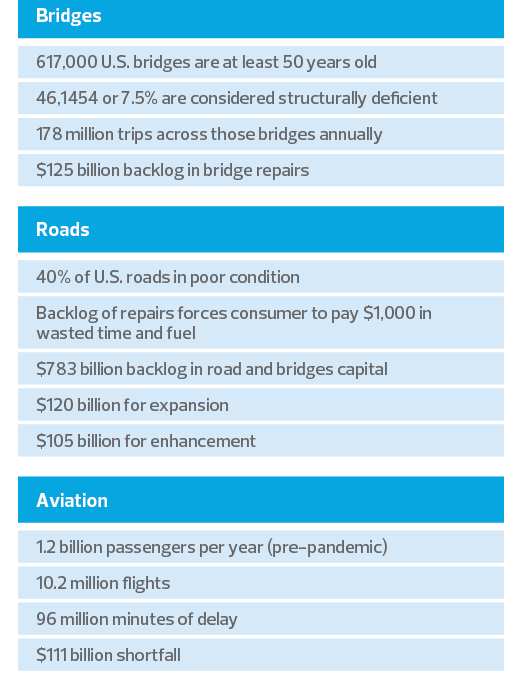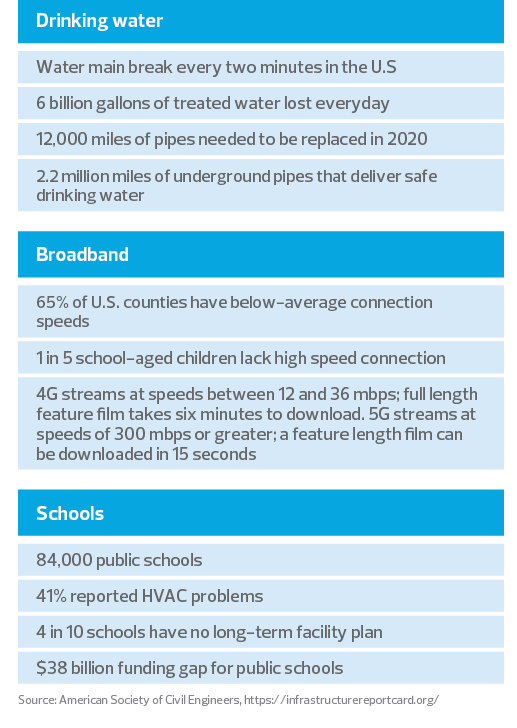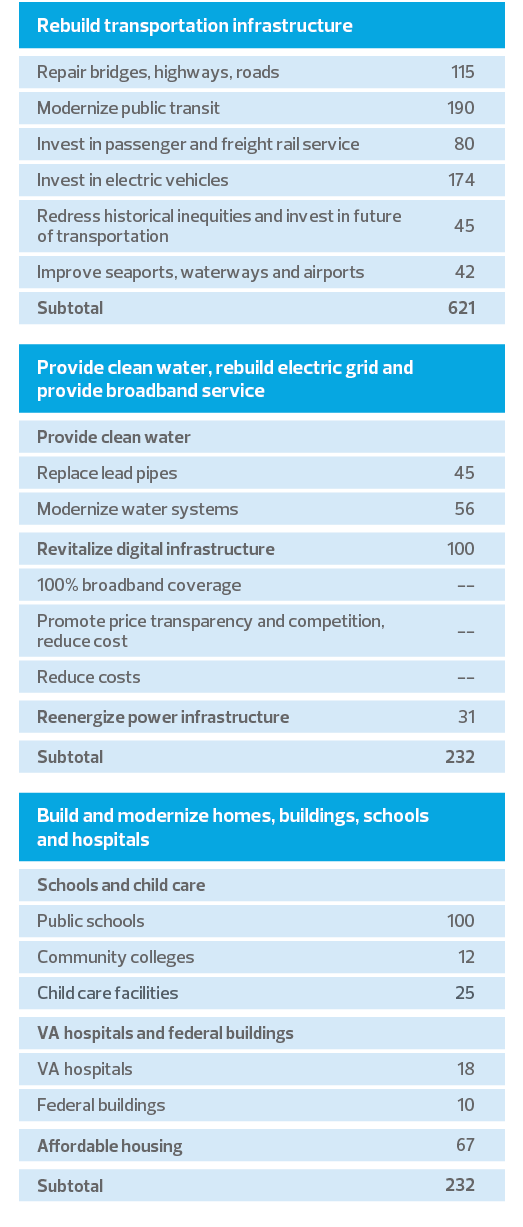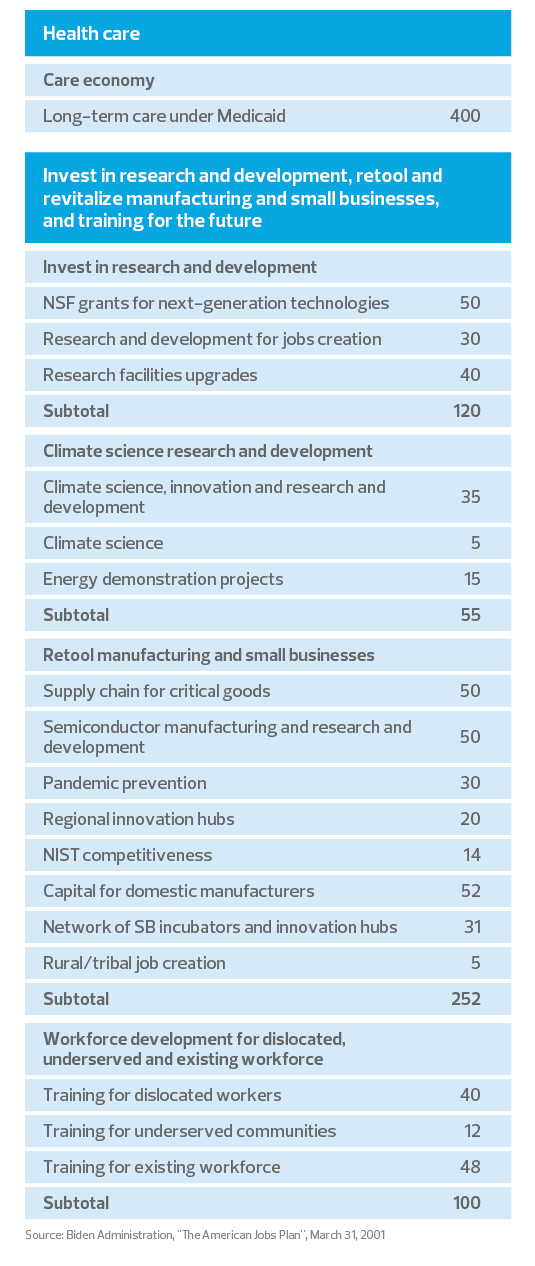The latest report card on the nation’s infrastructure from the American Society of Civil Engineers confirms what just about everyone already knows: It’s old; it’s broken, and it doesn’t work anymore.
To address this gap, the Biden administration has proposed spending roughly $2 trillion over the next decade. Among the initiatives are $621 billion for roads, bridges and highways; $480 billion to facilitate manufacturing growth and research, and $213 billion for housing infrastructure. The rest would go to projects, including productivity-enhancing investment in technological infrastructure and resilient environmental infrastructure, as well as expanding access to home care.
It was of little surprise that the ASCE communicated the need for a multitrillion-dollar, decade-long effort to align America’s national infrastructure with its economic and social needs. In 2019, the United States spent only 2.5% of gross domestic product on infrastructure, down from 4.2% in the 1930s. This implies a shortfall of close to $3.7 trillion over the next decade.
The economics of such a project are straightforward. A project that modernizes the national infrastructure means increased jobs, productivity and growth, all of which will result in a meaningful increase in the living standards for Americans.
In our estimation, a $2 trillion infrastructure project would result in an additional $6.1 trillion in economic activity over the next decade, result in an improvement in gross domestic product of 0.4% per year and add 3.2 million jobs to total employment over 10 years.
In addition, with the term structure of interest rates likely to be negative over the next year or two, now is the time to act boldly and with intent.
Understanding what such an ambitious infrastructure project entails is almost as challenging as figuring out how to pay for it. Since nothing of this scale has been attempted since the Eisenhower administration of the 1950s, such a project may require explanation.
MIDDLE MARKET INSIGHT
A project that modernizes the national infrastructure means increased jobs, productivity and growth, all of which will result in a meaningful increase in the living standards for Americans. From our vantage point, a modern-day effort to improve America’s infrastructure will create the conditions for an acceleration and transformation toward the digital future of the American economy.
The foundation of that effort will likely revolve around the concept of what might be called I2R. We would define I2R in three parts.
First component: Big I
The first part would be what we refer to as “Big I,” or the repair, rehabilitation or construction of traditional infrastructure projects like roads, bridges, ports, waterways, water delivery, sewers, rail, public transit, public aviation and public sector ventilation systems at schools.
These are the big, time-consuming and expensive projects that underscore everyday life. The federal government has done these before, financing and building the national highway system, the transcontinental railroad, Hoover Dam and the Erie Canal. These are the public projects that the private sector neither has the financial depth to finance or build on its own.
Second component: Little i
The second part is what we would refer to as “Little i,” or the critical infrastructure of the digital economy. This includes 5G, broadband, electric charging stations, public health and other infrastructure to support the use of data analytics, internet of things, artificial intelligence and machine learning to push the outer boundaries of productivity that can lift living standards.
This will require innovative public-private partnerships to extend broadband and 5G connectivity to every corner of the U.S. economy. The need for this and its importance in the new economy became particularly apparent during the pandemic when so many people could not go to school or work because of lack of broadband.
Third component: R
The third component of any infrastructure program will revolve around “R,” or making critical infrastructure resilient. Such things as power and electrical grids need to be brought up to code to withstand current and future shocks associated with climate change, and to ensure that geostrategic competition and conflict do not result in a widespread power, financial or communications disruptions.
The recent near-catastrophic collapse of the Texas energy grid because of a significant winter storm or the SolarWinds cyberattack that compromised private and public sector assets both should serve as a clarion call that the status quo is not sustainable. These needs demand to be addressed before the cost of doing so becomes prohibitive.
How to pay for this?
The first and most understandable question is how to pay for this. We think that the optimal path would be to provide seed capital for a national infrastructure bank and then use the broad and deep American capital markets to leverage that up to meet those needs.
Under this approach, Congress would provide $400 billion in seed capital next year, which the national infrastructure bank would then leverage up over the next 10 years to modernize I2R so it aligns with where the economy is heading and could achieve $4 trillion in net infrastructure investment.
The national infrastructure bank could then take proceeds from the issuance of bonds to reinvest back into the development and innovation around future projects. This would be a legacy project that solves the issue of infrastructure once and for all. But the likelihood of such a bank being created is low.
What is more likely to happen is a mix of tax increases. Among the proposals is an increase in the corporate tax rate from 21% to 28%, but negotiations have only just begun. In addition, the Biden administration campaigned on a promise not to raise taxes on anyone earning less than $400,000.
Whatever the case, it is critical that policymakers take advantage of the negative real rate environment. Following the shock of the pandemic, the Federal Reserve implemented a series of policies that have resulted in extremely low interest rates.
This presents the opportunity for long-term investment at negative inflation-adjusted interest rates. That is, the cost of newly issued debt will be paid in deflated dollars, resulting in investments that actually pay for themselves.
Is this politically doable?
Just as difficult as financing the project will be garnering political support in a U.S. Senate that is controlled by Democrats under a 50-50 split. Joe Manchin, Democrat of West Virginia, is thought to be a swing vote, and has indicated support for increasing the corporate tax rate to 25%.
Moreover, without any significant Republican Party support, Democrats will need to use budget reconciliation to move this legislation, which suggests that they will have to raise substantial revenue to meet the requirements under the Byrd rule that governs reconciliation.
This implies that if revenues are raised to meet the requirements under reconciliation, then it would result in a drag on overall economic growth in 2022 and 2023.






